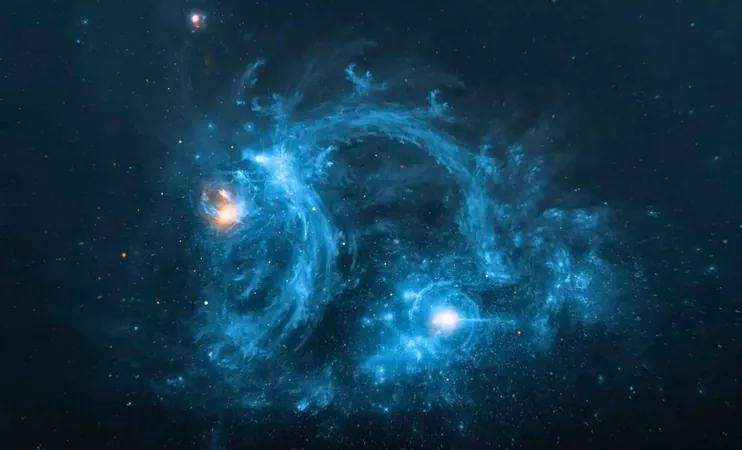
James Webb Telescope Discovers the Groundbreaking ‘Einstein Zig-Zag’—A Potential Game-Changer for Cosmology!
2024-11-21
Author: Ling
The Journey of the Einstein Zig-Zag
Back in 2018, astronomers peered deep into the cosmos and stumbled upon an extraordinary sight: four identical bright points glowing in the vast darkness of space. They were later identified as J1721+8842, which were initially interpreted as mirror images of a singular quasar, created by a phenomenon known as gravitational lensing. This incredible optical effect occurs when massive celestial bodies distort space-time, allowing them to bend light around them and create various mirror-like images or halos—often referred to as Einstein rings.
However, new studies have unveiled two additional points of light and a faint red Einstein ring, all originating from the same quasar. With the JWST's unprecedented capabilities, researchers revealed that the light had traveled through not one, but two gravitational lenses, creating the intricate zig-zag pattern that could potentially alter our comprehension of space-time and how it operates.
The Gravitational Lensing Technique
Gravitational lensing isn't just an awe-inspiring phenomenon; it serves as a cosmic measuring tool. By analyzing the warped paths of light, astrophysicists can gauge the mass of galaxies, delve into the mysteries of dark matter, and compute the Hubble constant—the parameter that defines the universe's expansion rate. However, data from JWST has revealed a perplexing issue known as the Hubble tension, where certain measurements show different rates of expansion in various regions of the universe.
Einstein Zig-Zag: A Solution to Hubble Tension?
The Einstein zig-zag might be a pivotal breakthrough in addressing this tension. Its complex pattern provides astronomers with opportunities to refine their measurements not just of dark energy—the elusive force driving the acceleration of cosmic expansion—but also of the Hubble constant itself. This unique opportunity may pave the way to resolve some of the deep-seated inconsistencies that plague current cosmological models.
The Importance of Patience for Future Insights
While the discovery of the Einstein zig-zag is certainly exhilarating, the real marvel lies in the meticulous work that follows. Precise calculations and analyses of the light's pathways through space-time are critical and may take years to complete. As Dr. Thomas Collett, an esteemed astrophysicist, emphasizes, the resolve of these measurements could either bolster or challenge existing cosmic theories, fundamentally reshaping our understanding of the universe and its enigmatic properties.
This monumental advancement not only propels astronomy into new territories but also reignites curiosity about the universe's vast potential. What other mysteries lie within the cosmos, waiting for the keen eyes of scientists like those at JWST to uncover? Stay tuned, because the future of cosmology is about to get even more thrilling!
 Brasil (PT)
Brasil (PT)
 Canada (EN)
Canada (EN)
 Chile (ES)
Chile (ES)
 España (ES)
España (ES)
 France (FR)
France (FR)
 Hong Kong (EN)
Hong Kong (EN)
 Italia (IT)
Italia (IT)
 日本 (JA)
日本 (JA)
 Magyarország (HU)
Magyarország (HU)
 Norge (NO)
Norge (NO)
 Polska (PL)
Polska (PL)
 Schweiz (DE)
Schweiz (DE)
 Singapore (EN)
Singapore (EN)
 Sverige (SV)
Sverige (SV)
 Suomi (FI)
Suomi (FI)
 Türkiye (TR)
Türkiye (TR)